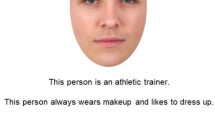Abstract
The present study explored the characteristics of social categorization based on the unidimensional variation of gender or age using the Garner’s Selective Attention Paradigm. The task of the experiment was to judge whether there was a mole on a person’s face, and the results showed that young participants’ response times were slower when the age or gender of the face stimuli varied, demonstrating that young people, rather than older people, can activate both an age category and a gender category automatically. Meanwhile, all participants’ responses to the old faces were slower than that to the young faces. Females reacted faster than males, demonstrating that females tend to have an advantage for face processing.


Similar content being viewed by others
References
Bai L, Ma H, Huang YX (2005) The development of native Chinese affective picture system—A pretest in 46 college students. Chin Ment Health J 19:719–722 (in Chinese)
Berry DS, McArthur LZ (1986) Perceiving character in faces: the impact of age-related craniofacial changes on social perception. Psychol Bull 100(1):3–18
Crookes K, Favelle S, Hayward WG (2013) Holistic processing for other-race faces in chinese participants occurs for upright but not inverted faces. Front Psychol 4(2):258–264
Daniel S, Bentin S (2012) Age-related changes in processing faces from detection to identification: ERP evidence. Neurobiol Aging 33(1):206.e1–206.e28. http://www.plosone.org/article/findcited/6122867
Ebner NC, Johnson MK (2009) Young and older emotional faces: are there age-group differences in expression identification and memory? Emotion 9(3):329–339
Finkel D, Reynolds CA, McArdle JJ, Pedersen NL (2007) Age changes in processing speed as a leading indicator of cognitive aging. Psychol Aging 22:558–568
Garner WR (1974) The processing of information and structure. Erlbaum, Potomac
Gottlob LR, Fillmore MT, Abroms BD (2007) Age-group differences in inhibiting an oculomotor response. Aging Neuropsychol Cognit 14(6):586–593
Hampson E, van Anders SM, Mullin LI (2006) A female advantage in the recognition of emotional facial expressions: test of an evolutionary hypothesis. Evol Hum Behav 27(6):401–416
Hofmann SG, Suvak M, Litz BT (2006) Sex differences in face recognition and influence of facial affect. Personal Individ Differ 40(8):1683–1690
Ino T, Nakai R, Azuma T, Kimura T, Fukuyama H (2010) Gender differences in brain activation during encoding and recognition of male and female faces. Brain Imaging Behav 4(1):55–67
Jost K, Bryck RL, Vogel EK, Mayr U (2011) Are old adults just like low working memory young adults? Filtering efficiency and age differences in visual working memory. Cereb Cortex 21(21):1147–1154
Kang HG, Dingwell JB (2008) Effects of walking speed, strength and range of motion on gait stability in healthy older adults. J Biomech 41(14):2899–2905
Kloth N, Damm M, Schweinberger SR, Wiese H (2015) Aging affects sex categorization of male and female faces in opposite ways. Acta Psychol 158:78–86
Lewin C, Herlitz A (2002) Sex differences in face recognition: women’s faces make the difference. Brain Cogn 50(1):121–128
Macrae CN, Quinn KA, Mason MF, Quadflieg S (2005) Understanding others: the face and person construal. J Pers Soc Psychol 89(5):686–695
Maner JK, Miller SL, Leo J, Plant EA (2012) Motivated social categorization: fundamental motives enhance people’s sensitivity to basic social categories. J Pers Soc Psychol 103(1):70–83
Mason MF, Cloutier J, Macrae CN (2006) On construing others: category and stereotype activation from facial cues. Soc Cognit 24(5):540–562
Megreya AM, Memon A, Havard C (2012) The headscarf effect: direct evidence from the eyewitness identification paradigm. Appl Cognit Psychol 26(2):308–315
Nisbett RE, Peng K, Choi I, Norenzayan A (2001) Culture and systems of thought: holistic versus analytic cognition. Psychol Rev 108(2):291–310
Okazaki Y, Abrahamyan A, Stevens CJ, Ioannides AA (2010) Wired for her face? Male attentional bias for female faces. Brain Topogr 23(1):14–26
Park DC, Lautenschlager G, Hedden T, Davidson NS, Smith AD, Smith PK (2002) Models of visuospatial and verbal memory across the adult life span. Psychol Aging 17(2):299–320
Quinn KA, Macrae CN (2005) Categorizing others: the dynamics of person construal. J Pers Soc Psychol 88(3):467–479
Salthouse TA (1985) Speed of behavior and its implications for cognition. In: Birren JE, Schaie KW (eds) Handbook of the psychology of aging, 2nd edn. Van Nostrand Reinhold, New York, pp 400–426
Sun YT, Gao XC, Han SH (2010) Sex differences in face gender recognition: an event-related potential study. Brain Res 1327:69–76
Tun PA, Lachman ME (2008) Age differences in reaction time and attention in a national telephone sample of adults: education, sex, and task complexity matter. Dev Psychol 44(5):1421–1429
Voelkle MC, Lindenberger U, Riediger M, Ebner NC (2012) Let me guess how old you are: effects of age, gender, and facial expression on perceptions of age. Psychol Aging 27(2):265–277
Wiese H, Schweinberger SR, Neumann MF (2008) Perceiving age and gender in unfamiliar faces: brain potential evidence for implicit and explicit person categorization. Psychophysiology 45(6):957–969
Wiese H, Kachel U, Schweinberger SR (2013a) Holistic face processing of own- and other-age faces in young and older adults: ERP evidence from the composite face task. Neuroimage 74(4):306–317
Wiese H, Komes J, Schweinberger SR (2013b) Ageing faces in ageing minds: a review on the own-age bias in face recognition. Visual Cognit 21(9):1337–1363
Wolff N, Kemter K, Schweinberger SR, Wiese H (2013) What drives social in-group biases in face recognition memory? ERP evidence from the own-gender bias. Soc Cognit Affect Neurosci 9(5):580–590
Acknowledgements
This research was supported by grants from the Key Project of Chinese Social Science (Grant No. 12AD117).
Author information
Authors and Affiliations
Corresponding author
Additional information
Handling Editor: Don Ross, Cape Town University.
Reviewers: Holger Wiese, Durham University, Hiroshi Fukuyama, Kyoto University.
Rights and permissions
About this article
Cite this article
Wang, P., Zhang, Q., Liu, Y. et al. The characteristics of social categorization based on the unidimensional variation of gender versus age. Cogn Process 18, 31–37 (2017). https://doi.org/10.1007/s10339-016-0777-2
Received:
Accepted:
Published:
Issue Date:
DOI: https://doi.org/10.1007/s10339-016-0777-2




